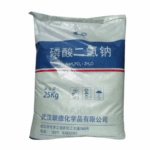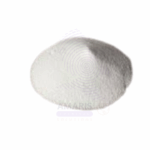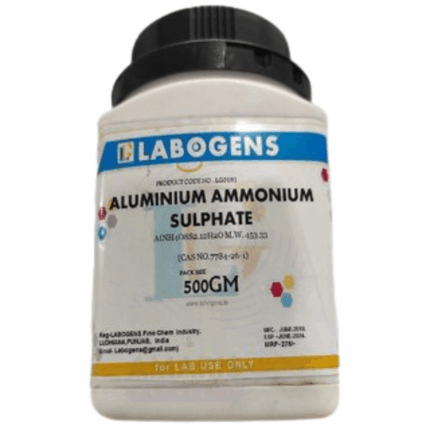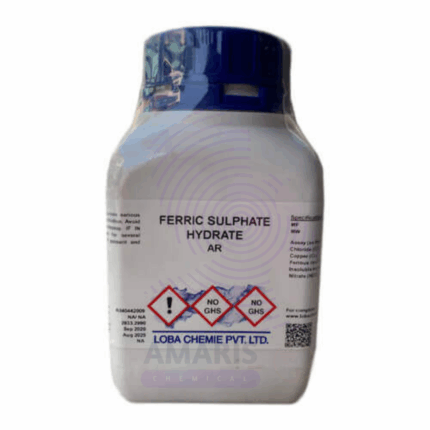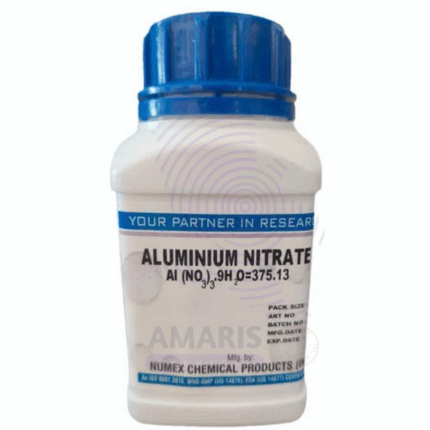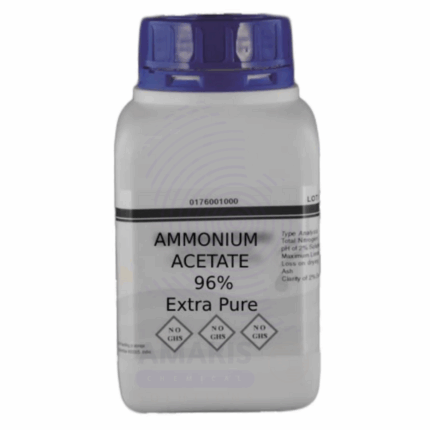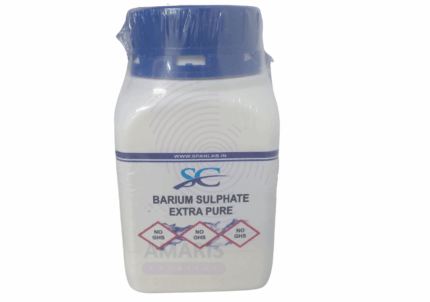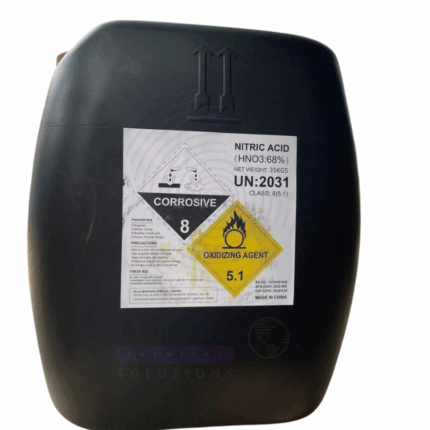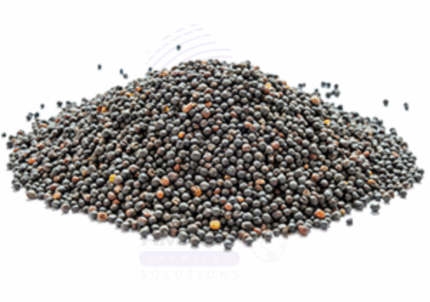Sodium Diphenylamin Sulphonate
Whatsapp Order
Sodium Diphenylamin Sulphonate is a white to light brown crystalline powder used primarily as an antioxidant and stabilizer in various industrial applications. It functions by inhibiting the oxidation of materials such as rubber, lubricants, and fuels, thereby enhancing their shelf life and performance. This chemical is valued for its efficiency in preventing degradation caused by heat, light, and oxygen exposure. It also finds use as a reagent in analytical chemistry and in dye manufacturing processes.
Description
Table of Contents
Toggle
Sodium Diphenylamin Sulphonate
Primary Uses
- Rubber Industry
- Acts as an antioxidant and anti-degradant to prevent premature aging and cracking of rubber products.
- Improves the durability and lifespan of tires, hoses, and other rubber goods.
- Lubricants and Fuels
- Used as a stabilizer to prevent oxidation and maintain the quality of oils, greases, and fuels during storage and use.
- Dye and Pigment Industry
- Serves as an intermediate in the synthesis of dyes and pigments.
- Used as a reagent to enhance color stability and consistency.
- Analytical Chemistry
- Employed as an indicator or reagent in certain chemical assays and laboratory tests.
Secondary Uses
- Polymer Additives
- Incorporated in various polymer formulations to improve resistance against thermal and oxidative degradation.
- Metal Processing
- Sometimes used as a corrosion inhibitor in metalworking fluids and cooling lubricants.
KEY PRODUCT FEATURES
1. Basic Identification Attributes
- Chemical Name (IUPAC): Sodium 4-(phenylamino)benzenesulfonate
- Common/Trade Name: Sodium Diphenylamin Sulphonate
- CAS Number: 15325-10-5
- HS Code: 2921.49
- Synonyms: Sodium diphenylamine sulfonate, Sodium 4-aminodiphenyl sulfonate
2. Physical & Chemical Properties
- Physical State: Powder or crystalline solid
- Color & Odor: White to light brown; odorless
- Solubility: Soluble in water
- Density: Approx. 1.4 g/cm³
3. Safety & Hazard Attributes
- GHS Classification: May cause skin and eye irritation
- Toxicity: Low toxicity but avoid prolonged exposure
- Exposure Limits: Use appropriate industrial hygiene measures to minimize dust exposure
4. Storage & Handling Attributes
- Storage Conditions: Store in a cool, dry, well-ventilated place, protected from moisture and incompatible substances
- Container Type: Typically supplied in sealed plastic or fiber drums
- Shelf Life: Stable if stored under recommended conditions
- Handling Precautions: Use protective equipment; avoid dust generation and inhalation
- Storage Measures: Keep containers tightly closed and stored in a dry environment
5. Regulatory & Compliance Attributes
- Complies with industrial chemical safety regulations
- Used in formulations compliant with regional and international standards for antioxidants and stabilizers
6. Environmental & Health Impact
- Biodegradability: Not readily biodegradable
- Ecotoxicity: Should be handled to avoid environmental release; may be harmful to aquatic life at high concentrations
- Bioaccumulation: Not expected to bioaccumulate
SAFETY HANDLING PRECAUTIONS
Safety Handling Precautions
- PPE Required: Gloves, goggles, and dust mask recommended
- Handling Guidelines: Avoid inhalation and contact with skin or eyes; ensure good ventilation
- Storage Measures: Store away from strong oxidizers and moisture
First Aid Measures
- Inhalation: Move to fresh air; seek medical attention if irritation occurs
- Skin Contact: Wash thoroughly with soap and water; get medical advice if irritation develops
- Eye Contact: Rinse immediately with plenty of water for 15 minutes; seek medical attention if irritation persists
- Ingestion: Rinse mouth; seek medical attention if significant ingestion occurs
Firefighting Measures
- Fire Hazards: Non-flammable but may decompose under fire conditions producing toxic fumes
- Extinguishing Media: Water spray, foam, dry chemical, or CO₂
- Special Precautions: Wear full protective equipment and self-contained breathing apparatus
- Hazardous Combustion Products: Sulfur oxides, nitrogen oxides, and other toxic fumes
Related products
Aluminium Ammonium Sulphate Extra Pure
Aluminium Ammonium Sulphate Extra Pure, also known as ammonium alum, is a high-purity double salt composed of aluminum sulfate and ammonium sulfate, typically appearing as colorless or white crystalline granules. Valued for its excellent stability and solubility in water, it is widely used in analytical chemistry, dye mordanting, and laboratory reagent preparations. Its ability to precipitate proteins makes it useful in biochemical applications, while its astringent and antimicrobial properties support its role in pharmaceutical and cosmetic formulations. The extra pure grade ensures minimal impurities, making it suitable for high-precision scientific work. It should be stored in a tightly sealed container in a dry, cool area to prevent moisture absorption and maintain its effectiveness.
Aluminium Ferric Sulphate Extra Pure
Aluminium Ferric Sulphate Extra Pure is a high-purity, yellowish to light brown crystalline solid composed of aluminum, iron, and sulfate ions, commonly used in laboratory settings for analytical, coordination, and inorganic chemistry research. Its dual-metal composition makes it valuable for studying metal ion interactions, flocculation processes, and as a reagent in qualitative analysis of phosphates and tannins. The compound also finds application in preparing standard solutions and in experiments related to coagulation and sedimentation. Its extra pure grade ensures consistent performance with minimal contamination, making it ideal for precise, controlled experimentation. It should be stored in tightly sealed containers in a dry, cool environment to maintain stability and prevent moisture uptake.
Aluminium Nitrate Extra Pure
Aluminium Nitrate Extra Pure is a high-purity, white crystalline compound that is highly soluble in water and widely used in laboratory chemistry for analytical, synthesis, and research purposes. It serves as a reliable source of aluminum ions in solution, making it valuable in qualitative analysis, coordination chemistry, and materials science studies. This compound is often utilized in the preparation of other aluminum salts, as a nitrating agent, and in controlled oxidation reactions. Its extra pure grade guarantees minimal interference from contaminants, ensuring accurate, reproducible results in sensitive experimental work. Aluminium Nitrate should be stored in tightly sealed containers, away from moisture and incompatible substances, due to its oxidizing nature and hygroscopicity.
Ammonium Acetate Extra Pure
Ammonium Acetate Extra Pure is a high-purity, white crystalline solid that is highly soluble in water and commonly used as a buffer component in laboratory and analytical chemistry. It is especially valuable in high-performance liquid chromatography (HPLC), mass spectrometry, and biochemical assays where pH control and minimal ionic interference are essential. This compound also serves as a reagent in organic synthesis, particularly in the preparation of acetamides and other nitrogen-containing compounds. Its extra pure grade ensures excellent consistency, low contaminant levels, and compatibility with sensitive instrumentation. To maintain stability and prevent moisture absorption, it should be stored in a tightly sealed container in a cool, dry environment.
Barium Hydroxide Hydrate Extra Pure
Barium Hydroxide Hydrate Extra Pure is a high-purity, white crystalline compound containing eight molecules of water of crystallization. It is widely used in laboratory chemistry as a strong base in titration, qualitative analysis, and inorganic synthesis. Its high solubility in water and strong alkalinity make it valuable for neutralization reactions, preparation of barium salts, and as a reagent for detecting sulfates, carbonates, and phosphates. In analytical applications, it is often used where precise pH control and minimal contamination are critical. The extra pure grade ensures consistent performance in high-accuracy experiments. It should be handled with care and stored in a tightly sealed container in a cool, dry place, as it is caustic and sensitive to carbon dioxide in the air, which can lead to carbonate formation.
Barium Sulphate Extra pure
Barium Sulphate Extra Pure is a high-purity, white, odorless crystalline powder known for its extreme insolubility in water and chemical inertness, making it highly useful in laboratory settings for qualitative analysis and gravimetric determinations. It is commonly employed in the detection and quantification of sulfate ions through precipitation reactions, as well as in studies involving solubility equilibria and surface chemistry. Its high density and stability also make it valuable in preparing calibration standards and radiopaque materials in research. The extra pure grade ensures minimal contamination, providing consistent and reliable results in sensitive analytical procedures. It should be stored in a dry, tightly sealed container to maintain its quality and prevent contamination.
Nitric Acid
Nitric Acid is a concentrated aqueous solution of nitric acid (HNO₃) commonly used as a strong oxidizing acid in numerous industrial, laboratory, and manufacturing processes. It is a highly corrosive, colorless to yellowish liquid with a pungent odor. Nitric Acid 68% is fundamental in the production of fertilizers, explosives, dyes, and pharmaceuticals. It is also widely used in metal treatment, etching, and cleaning applications due to its powerful oxidizing and nitrating properties.
Rapeseed
Rapeseed is a plant-derived sample commonly analyzed in laboratories for its biochemical composition, including oil content, fatty acid profile, and protein levels. Laboratory testing of rapeseed helps in quality control for food processing, nutritional analysis, and industrial applications such as biofuel research. Samples of rapeseed seeds or extracted oils undergo chromatographic, spectroscopic, and other analytical procedures to determine purity, contaminants, and nutritional value. These tests support research in agricultural science, food technology, and pharmaceutical development


 Preservatives(food)
Preservatives(food) Flavor Enhancers
Flavor Enhancers Acidulants
Acidulants Sweeteners
Sweeteners Antioxidants
Antioxidants Colorants(food)
Colorants(food) Nutraceutical Ingredients (food)
Nutraceutical Ingredients (food) Nutrient Supplements
Nutrient Supplements Emulsifiers
Emulsifiers
 Collectors
Collectors Dust Suppressants
Dust Suppressants Explosives and Blasting Agents
Explosives and Blasting Agents Flocculants and Coagulants
Flocculants and Coagulants Frothers
Frothers Leaching Agents
Leaching Agents pH Modifiers
pH Modifiers Precious Metal Extraction Agents
Precious Metal Extraction Agents
 Antioxidants(plastic)
Antioxidants(plastic) Colorants (Pigments, Dyes)
Colorants (Pigments, Dyes) Fillers and Reinforcements
Fillers and Reinforcements Flame Retardants
Flame Retardants Monomers
Monomers Plasticizers
Plasticizers Polymerization Initiators
Polymerization Initiators Stabilizers (UV, Heat)
Stabilizers (UV, Heat)
 Antifoaming Agents
Antifoaming Agents Chelating Agents
Chelating Agents Coagulants and Flocculants
Coagulants and Flocculants Corrosion Inhibitors
Corrosion Inhibitors Disinfectants and Biocides
Disinfectants and Biocides Oxidizing Agents
Oxidizing Agents pH Adjusters
pH Adjusters Scale Inhibitors( water)
Scale Inhibitors( water)
 Antioxidants(cosmetic)
Antioxidants(cosmetic) Emollients
Emollients Fragrances and Essential Oils
Fragrances and Essential Oils Humectants
Humectants Preservatives
Preservatives Surfactants(cosmetic)
Surfactants(cosmetic) Thickeners
Thickeners UV Filters
UV Filters
 Fertilizers
Fertilizers Soil Conditioners
Soil Conditioners Plant Growth Regulators
Plant Growth Regulators Animal Feed Additives
Animal Feed Additives Biostimulants
Biostimulants Pesticides (Herbicides, Insecticides, Fungicides)
Pesticides (Herbicides, Insecticides, Fungicides)
 Active Pharmaceutical Ingredients (APIs)
Active Pharmaceutical Ingredients (APIs) Excipients
Excipients Solvents(pharmaceutical)
Solvents(pharmaceutical) Antibiotics
Antibiotics Antiseptics and Disinfectants
Antiseptics and Disinfectants Vaccine Adjuvants
Vaccine Adjuvants Nutraceutical Ingredients (pharmaceutical)
Nutraceutical Ingredients (pharmaceutical) Analgesics & Antipyretics
Analgesics & Antipyretics
 Analytical Reagents
Analytical Reagents Solvents(lab)
Solvents(lab) Chromatography Chemicals
Chromatography Chemicals Spectroscopy Reagents
Spectroscopy Reagents microbiology-and-cell-culture-reagents
microbiology-and-cell-culture-reagents Molecular Biology Reagents
Molecular Biology Reagents Biochemical Reagents
Biochemical Reagents Inorganic and Organic Standards
Inorganic and Organic Standards Laboratory Safety Chemicals
Laboratory Safety Chemicals Specialty Laboratory Chemicals(Special Laboratory Equipment)
Specialty Laboratory Chemicals(Special Laboratory Equipment)
 Demulsifiers
Demulsifiers Hydraulic Fracturing Fluids
Hydraulic Fracturing Fluids Scale Inhibitors(oil)
Scale Inhibitors(oil) Surfactants(oil)
Surfactants(oil) Drilling Fluids
Drilling Fluids
 Dyes and Pigments
Dyes and Pigments Bleaching Agents
Bleaching Agents Softening Agents
Softening Agents Finishing Agents
Finishing Agents Antistatic Agents
Antistatic Agents
 Admixtures
Admixtures Waterproofing Agents
Waterproofing Agents Sealants and Adhesives
Sealants and Adhesives Curing Compounds
Curing Compounds Concrete Repair Chemicals
Concrete Repair Chemicals Anti-Corrosion Coatings
Anti-Corrosion Coatings
 Surfactants(cleaning)
Surfactants(cleaning) Builders
Builders Enzymes
Enzymes Solvents (Cleaning)
Solvents (Cleaning) Fragrances
Fragrances
 Electronic Chemicals
Electronic Chemicals Catalysts
Catalysts Lubricants
Lubricants Photographic Chemicals
Photographic Chemicals Refrigerants
Refrigerants Automotive chemicals
Automotive chemicals Pyrotechnic Chemicals
Pyrotechnic Chemicals
 Biodegradable Surfactants
Biodegradable Surfactants Bio-based Solvents
Bio-based Solvents Renewable Polymers
Renewable Polymers Carbon Capture Chemicals
Carbon Capture Chemicals Wastewater Treatment Chemicals
Wastewater Treatment Chemicals
 Pigments
Pigments Solvents(paint)
Solvents(paint) Specialty Coatings
Specialty Coatings Binders/Resins
Binders/Resins Additives
Additives Driers
Driers Anti-Corrosion Agents
Anti-Corrosion Agents Functional Coatings
Functional Coatings Application-Specific Coatings
Application-Specific Coatings
 Fresh Herbs
Fresh Herbs Ground Spices
Ground Spices Whole Spices
Whole Spices Spice Blends
Spice Blends Dried Herbs
Dried Herbs
 Leavening Agents
Leavening Agents Dough Conditioners
Dough Conditioners Flour Treatments
Flour Treatments Fat Replacers
Fat Replacers Decoratives
Decoratives Preservatives(baking)
Preservatives(baking)
 Plasticizers & Softeners
Plasticizers & Softeners Reinforcing Agents
Reinforcing Agents Adhesion Promoters
Adhesion Promoters Vulcanizing Agents
Vulcanizing Agents Antidegradants
Antidegradants Blowing Agents
Blowing Agents Fillers & Extenders
Fillers & Extenders Accelerators & Retarders
Accelerators & Retarders
